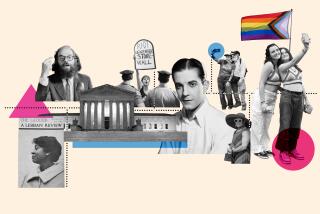Major Gay Archives Find a Home at USC : History: Two merged collections have 2 million items. The arrangement shows academia’s growing acceptance of gay studies.
In an arrangement that underscores the growth of gay studies in academia, USC will soon be home to one of the world’s largest gay archives.
The university has agreed to house two recently merged Los Angeles collections that together include about 2 million items. From thousands of books and newspaper clippings to political buttons and bar matchbooks, the archives provide a sweeping chronicle of gay life and politics in this century.
“The combined collections . . . are among the finest collections of such material under one roof anywhere,” said Lynn Sipe, acting director of University Libraries at USC, which is providing campus space for the archives in return for university access to the material.
The agreement is testament not only to the increasing acceptance of gay studies, but also to the indefatigability of those who built up the collection, made up of the International Gay and Lesbian Archives and the ONE Inc. library holdings.
The international archives, the larger of the two, traces its origins to 1942. Jim Kepner, newly arrived in San Francisco from Texas, went to the public library, eager, he says, to know “what being gay was all about and where we’d been all those dark ages.”
He couldn’t find anything, so he started collecting books on his own. It was the beginning of his career as a pack rat extraordinaire. What others might have hidden or discarded, Kepner filed away. He was unable to resist any scrap of the gay experience, whether grand or trivial.
Now the archives, run since the late 1970s by a nonprofit board, are a sprawling mass of material stacked floor to ceiling in rooms scattered throughout Los Angeles. Literature, history and sociology books cram the homemade shelves of the archives’ main space in a leaky West Hollywood city building, while boxes of papers and battered filing cabinets line the aisles.
The memorabilia ranges from a 1906 edition of a German gay magazine to a pink leather motorcycle outfit worn at a Los Angeles gay charity event. Along with manuscripts, political posters and drawings by gay artists, there are videos, photos, letters and hundreds of matchbooks from gay bars.
It is not simply curiosity that has driven Kepner and the volunteers who have devoted themselves to cataloguing and staffing the collections. They also are fired by a sense of history and community often denied gay men and lesbians.
“One of our problems as gay and lesbian people is finding our roots,” said John O’Brien, acting president of the ONE Institute, the ONE Inc. affiliate that administers the merged collections. “It’s so important for people to know who and what they came from.”
These champions of gay history are acutely aware of how often it has been ignored or destroyed in the past. They speak of Nazi book burnings that reduced German gay collections to ashes. And they have no intention of relinquishing control of the archives.
Another university had expressed interest in the material but wanted possession of it, Kepner said. USC, on the other hand, was willing to let ONE retain ownership.
USC also had Walter Williams, an anthropology professor who has served on the boards of both ONE and the international archives.
Williams, who teaches in USC’s Program for the Study of Women and Men in Society, used both collections for his research on homosexuality in non-Western cultures.
“I realized how valuable these were,” said Williams, noting that the archives contain information he could not find elsewhere.
Knowing that the archives were in desperate need of more space, Williams approached USC officials and a deal was worked out: The collection would be given use of a 14,000-square-foot campus building on a five-year, renewable contract basis. USC would provide maintenance, while ONE would renovate the former child guidance center, install security and staff the collection. The archives, scheduled to open this spring, will be available to the public as well as to USC faculty and students.
Williams said about 20 USC faculty members do research in the gay studies field, which is gradually gaining recognition. More than 45 American colleges and universities offer at least one course in the gay experience, according to the National Gay and Lesbian Task Force, and at San Francisco State University, students can now earn a minor in the subject.
Currently, Sipe said, USC has little in the way of gay-related archival and specialized material. The addition of the collections will “greatly enrich the academic enterprise at USC for study in this area,” he said.
USC also is negotiating with other gay archives to house their material, including the June L. Mazer Lesbian Collection, now located in the same West Hollywood building as the international archives.
“We would like to be connected with them and get more exposure for the Mazer collection,” said Kim Kralj, Mazer board president. Much smaller than the ONE archives, the 14-year-old collection includes books, magazines, unpublished manuscripts and photographs.
The merger of the ONE and the international archives coincides with the end of an era for ONE, an early gay organization founded in 1952 as an outgrowth of the pioneering Mattachine Society.
ONE published the first public American magazine for and by homosexuals, even going to the U.S. Supreme Court to win the right to send it through the mail. As far back as the 1950s, the group offered classes in “homophile studies,” later conferring degrees.
While the gay movement grew and evolved, ONE stayed true to the vision of its eccentric dean, William Dorr Legg, who died last year at 89. Clinging to the old-fashioned term homophile and discounting more confrontational notions of gay activism, ONE and Legg were eclipsed.
“He was a dedicated man,” said John DeCecco, the head of gay and lesbian studies at San Francisco State. “But like so many people who get absorbed in one cause, he was never able to see the larger developments going on in gay, lesbian and bisexual studies. . . . He became something of an anachronism.”
With Legg’s death, ONE is working out a new identity. The course offerings have been suspended. The group is selling its Country Club Park headquarters on the Milbank Estate to pay off debt stemming from a backlog of property taxes, said David Cameron, board president of ONE Inc.
For Kepner, the merger of the ONE and international collections represents the closing of a circle. An early ONE member, he helped start the ONE library in the 1950s. “In a way it’s like putting two parts of my life back together,” he said.
Coming from a generation of homosexuals who experienced little but hostility from the institutional world, Kepner confesses some amazement at USC’s willingness to take the material.
“All of the public institutions for many, many years seemed like our enemies. So it’s very astonishing.”
More to Read
Sign up for Essential California
The most important California stories and recommendations in your inbox every morning.
You may occasionally receive promotional content from the Los Angeles Times.











